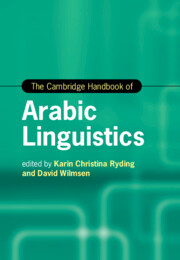Book contents
- The Cambridge Handbook of Arabic Linguistics
- Cambridge Handbooks in Language and Linguistics
- The Cambridge Handbook of Arabic Linguistics
- Copyright page
- Contents
- Figures
- Tables
- Notes on Contributors
- Acknowledgements
- Abbreviations
- Introduction
- Part I Arabic Applied Linguistics
- Part II Arabic Variation and Sociolinguistics
- Part III Theoretical and Descriptive Studies
- 12 Grammaticalization in Arabic
- 13 Arabic and Onomastics
- 14 The Intonation of Arabic
- 15 Case in Arabic
- 16 On Arabic Morphosyntax and Its Implications for the Theory of Generative Grammar
- 17 Arabic Morphology
- Part IV Arabic Computational and Corpus Linguistics
- Part V Arabic Linguistics and New Media Studies
- Part VI Arabic Linguistics in Literature and Translation
- Index
- References
12 - Grammaticalization in Arabic
from Part III - Theoretical and Descriptive Studies
Published online by Cambridge University Press: 23 September 2021
- The Cambridge Handbook of Arabic Linguistics
- Cambridge Handbooks in Language and Linguistics
- The Cambridge Handbook of Arabic Linguistics
- Copyright page
- Contents
- Figures
- Tables
- Notes on Contributors
- Acknowledgements
- Abbreviations
- Introduction
- Part I Arabic Applied Linguistics
- Part II Arabic Variation and Sociolinguistics
- Part III Theoretical and Descriptive Studies
- 12 Grammaticalization in Arabic
- 13 Arabic and Onomastics
- 14 The Intonation of Arabic
- 15 Case in Arabic
- 16 On Arabic Morphosyntax and Its Implications for the Theory of Generative Grammar
- 17 Arabic Morphology
- Part IV Arabic Computational and Corpus Linguistics
- Part V Arabic Linguistics and New Media Studies
- Part VI Arabic Linguistics in Literature and Translation
- Index
- References
Summary
This chapter discusses state-of-the-art research in Arabic grammaticalization studies, providing an extensive review of literature, periodizing the growth of research in this field, and outlining research challenges as well as future possibilities. Grammaticalization in Arabic reflects the processes of grammaticalization in general as it refers to the gradual shift and transformation of major parts of speech into particles, function words, or even bound morphemes with little semantic content but important and even necessary syntactic functions. Key questions are raised about the validity and importance of diachronic reconstruction for Arabic, the relation between written and spoken Arabic, the availability of suitable corpora for analysis, and the lack of an overall agreed framework or venue for Arabic grammaticalization research.
Keywords
- Type
- Chapter
- Information
- The Cambridge Handbook of Arabic Linguistics , pp. 277 - 308Publisher: Cambridge University PressPrint publication year: 2021
References
References
arabiCorpus: http://arabicorpus.byu.edu
Tunisian Arabic Corpus: www.tunisiya.org
Corpora
arabiCorpus: http://arabicorpus.byu.edu
Tunisian Arabic Corpus: www.tunisiya.org
- 1
- Cited by

